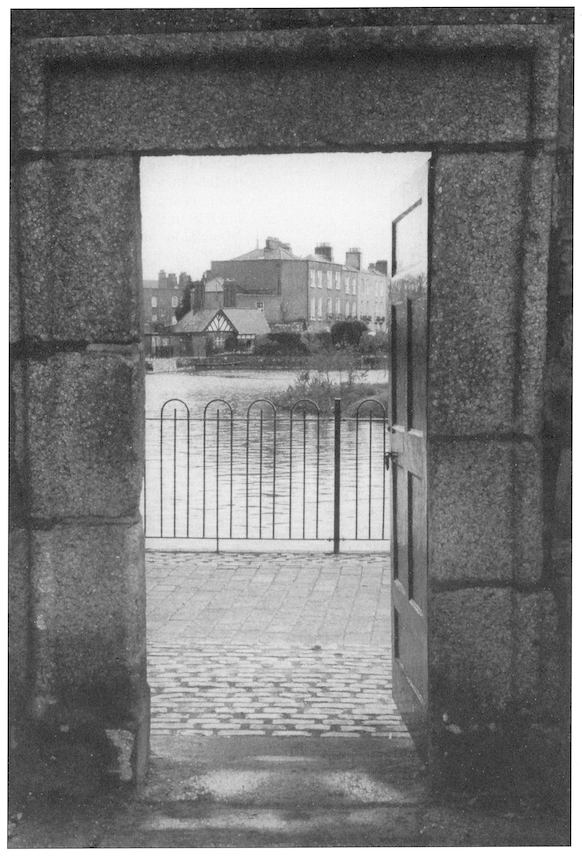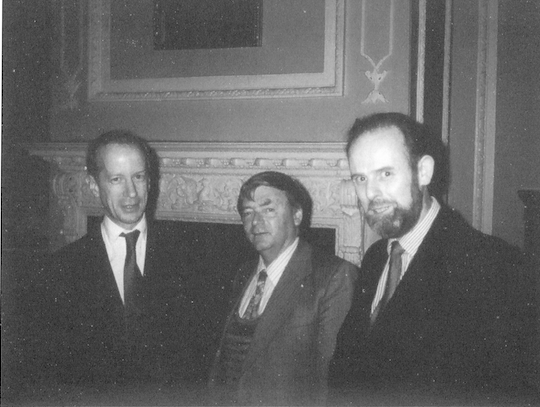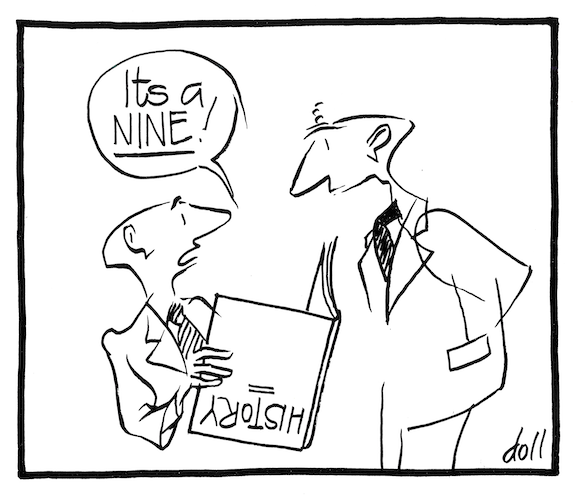
Enquiries: David Day, Department of Modern History, UCD.
Huguenot archive for Ireland launched
The Irish Section of the Huguenot Society of Great Britain and Ireland held a reception in the Church of Ireland Theological College, Dublin, on 24 September 1994, at which the Huguenot Archive in the Representative Church Body Library, Dublin 14, was formally launched.
Fellows of the Society and its Irish Section committee, with their chairperson, Henry Tierney, welcomed many distinguished guests both from Ireland and further afield, including Randolph Vigne, editor of the Huguenot magazine Proceedings who brought not only good wishes from the Society’s President, Kenneth Bradford and the UK committee, but also a gift from London of microfiche material for the archive. His Grace, the Archbishop of Dublin, Dr. Donald Caird, presided.
The urgent need for a home of good standing for the collection of books, manuscripts, family papers, photographs and artifacts relating to the history of the French Protestant (Huguenot) and Belgian Protestant (Walloon) communities in Ireland has been keenly felt by the Irish Section for some time. Valuable historical material needs to be placed where it can be made available for consultation by, and safeguarded for the future use of, researchers, students and all those who may be interested. An established archive will encourage those who may have valuable historical and/or family material to make this available either by donation or by permanent loan.
The strong historical links between the Huguenots and the Church of Ireland—to which most Huguenot families conformed—gave rise to the suggestion that the Huguenot Archive should be placed with the RCB Library, the Church of Ireland’s main reference library and archive repository under the care of its curator Raymond Refaussé.
Enquiries: Annette Camier, ‘Sunhaven’, Celbridge, County Kildare. Tel.: (01) 6271189.
Maynooth College Graduates’ Reunion Day to celebrate Bicentenary
Maynooth College celebrates it bicentenary in 1995 and as an integral part of these festivities a Graduates’ Reunion Day is planned for next year. The aim is to facilitate the largest ever gathering of Maynooth graduates in its two-hundred-year history.
The college proudly boasts over 10,000 graduates spread throughout the world and each is welcome to return to their Alma Mater on this Reunion Day in April 1995. The objective is to give everyone the chance to savour the taste of Maynooth tradition, evoking many happy memories and reuniting old friends.
Enquiries: Bicentenary Graduate Committee, St Patrick’s College, Maynooth, Co. Kildare. Tel.: 353-1-7083968. Fax: 353-1-6289373.
Committee members: Ronan Barry, Marie-Therese Kilmartin, Denis Leamy, Joanne Costello, Fergus Heneghan and Catherine Fox.
Gulbenkian/Norwich Union Awards for museums and galleries in Ireland
The Minister for Arts, Culture and the Gaeltacht, Michael D. Higgins, TD announced the winners of the 1994 Gulbenkian/Norwich Union Awards for museums and galleries in Ireland at a function in the Royal College of Physicians of Ireland last October. The Awards are given in recognition of outstanding achievement and improvement in Ireland’s museums and galleries. Applicants were invited from both north and south of the border. A panel of nine judges, representing both heritage interests and the media, adjudicated this year’s entries. The scheme is chaired by the Director of the Northern Ireland Museums Council.
Speaking at the presentation ceremony the Minister said: ‘To reward excellence is always a pleasure and I am delighted to have the opportunity to announce the winners today. It is important that we recognise the efforts made by museums and galleries throughout the country to providing cultural education and stimulation to the public’. This is the third year of the scheme and a total prize fund of £6,500 was presented to the winners of the four categories.
* Gulbenkian Irish Museum Award (confined to museums with an annual budget in excess of £500,000): £2,000 to the Ulster Folk and Transport Museum, Co. Down for the ‘Irish Railway Collection’.
* Norwich Union Museum Award (confined to museums with an annual budget of below £500,000): £2,000 to the Famine Museum, Strokestown, Co. Roscommon.
* Best Visitor Care Award: £1,000 to Fermanagh County Museum, Enniskillen, Co. Fermanagh.
* Best Museum Education Project: £1,000 to Fermanagh County Museum.
* Special Commendation: £500 to the Foynes Flying Boat Museum, Co. Limerick.
Further information: Anne Mathews, PRO, (01) 6717181.
Roscrea Autumn Conference
The 15th Roscrea conference (organised as usual by George Cunningham) was held on the first weekend of November in the Cistersian Abbey of Mount St Joseph., on the theme Aspects of landscape and settlement in medieval Ireland. Frank Mitchell performed the official opening on Friday evening and on the following morning discussed Medieval Valencia—does it exist? Matthew Stout, HI’s very own cartographer, delivered an overview on the theme of the weekend and also participated in a presentation of a case study of the south-west midlands along with John Feehan and George Cunningham, which was followed up by field trips to the territory of Ely O’Carroll, concentrating on the towerhouse at Leap, and to the restored towerhouse at Ballaghmore in Ossory.
Ronnie Buchanan detailed the advance and settlement of The Normans in the North, and also entertained on Saturday evening with a light-hearted review of the work of the Institute of Irish Studies in Belfast. Equally entertaining was George Cunningham’s Quizzical tour through medieval Ireland.
On Sunday Aidan O’Sullivan gave fresh insights into Fishweirs and fishponds in medieval Ireland; Geraldine Stout explored the medieval landscape of Newgrange; and Kevin Whelan ranged in an interdisciplinary manner over the centuries, teasing out the long-term effects of Anglo-Norman settlement, remarking that ‘we should be looking for continuity rather than fractures’. He also gave a short progress report on the proposed new Atlas of the rural Irish landscape, aided by an interesting exhibition mounted by Matthew Stout.
The Roscrea Spring Conference, 21-23 April 1995, will focus on perceptions and reactions to the landscape of the early middle ages.
Enquiries: George Cunningham, Parkmore, Roscrea, Co. Tipperary. Tel.: (0505) 21619.
Kilmainham exhibition
Kilmainham Gaol Museum is planning an exhibition for its new museum in April 1996. As the available history of the gaol’s political prisoners 1916-1924 is extremely fragmented (no gaol registers exist), names and testimonies of former prisoners would be extremely valuable. Any memorabilia, letters, newspaper cuttings, photographs or related material pertaining to this or any period of the gaol’s history which could be loaned would be greatly appreciated. In particular there is very little material in its present collection pertaining to women prisoners so anything on Cumann na mBan or Inghinidhe na hÓireann would be of great value. For example, can any HI readers identify the members of Inghinidhe na hÓireann pictured here with Maud Gonne?
Enquiries: Sinéad McCoole, Kilmainham Gaol Museum, Inchicore Road, Dublin 8. Tel.: (01) 4535984. Fax: (01) 4532037.

Genealogists make demands
A general meeting of the participants on the last day of the Second Genealogical Congress (28 September) passed resolutions demanding the following:
* Extended opening hours in such record repositories as the General Register Office, the National Archives and the National Library.
* A comprehensive revised index for the Registry of Deeds, where the inadequate manuscript indexes are irreparably damaged through over use.
* Access to copies of original church records up to the year 1900. At present records from five Catholic dioceses are on restricted access at the National Library on instruction from the relevant bishops. Records of some other churches are also closed to the public.
* Improved access to indexes in genealogical (‘heritage’) centres throughout Ireland.
* The creation of the National Sign Posting Index promised as part of the Irish Genealogical Project to give people access to information in heritage centres.
* Clarification of decisions regarding the relocation of the General Register Office from Dublin to Roscommon and a guarantee of an improved research facility at the GRO in Dublin.
There were approximately 540 participants at the Congress, nearly four times the number at the first one in 1991, from as far afield as Australia, Canada, England, France, the Isle of Man, the Netherlands, New Zealand, Scotland, South Africa, Spain, Switzerland, the USA, Wales and Ireland, North and South. A third Congress is planned for 1997.
Enquiries: Paul Gorry. Tel./Fax: (01) 8393942.
Blessington Street Basin reopened
Located in the heart of Dublin’s North Inner City, Blessington Street Basin has, for countless generations, proved a quiet haven in a bustling metropolis, a ‘secret garden’ for resident and visitor alike. Almost two acres in area and with a capacity of 4.7 million gallons, the basin commenced supplying the city with water in the autumn of 1810. Its water comes from Lough Owel, north of Mullingar, via the Royal Canal. In the 1860s it was superseded as a water supply for the city by the Vartry Resevoir system. Subsequently the Basin was used almost exclusively to supply the distilleries at Bow Street (Jameson’s) and John’s Lane (Power’s) until their closure in the 1970s.
In 1991 this forgotten corner of Georgian Dublin came to prominence when the Goethe Institute commisioned German landscape architect Dieter Magnus to produce a plan for the development of a modern ‘water garden’ as its contribution to the Dublin European City of Culture celebrations. Following a controversial rejection of the plan by local residents, Dublin Corporation’s Parks Division was charged with the task of refurbishment, which commenced in April 1993. The Basin was officially re-opened on 4 November by President Mary Robinson in the presence of the Lord Mayor, John Gormley.

New edition of Famine book
Lilliput Press and has recently launched a new edition The Great Famine: Studies in Irish History 1845-52, a collection of essays edited by R.D. Edwards and T.D. Williams, first published in 1956. At the launch in Newman House, St Stephen’s Green J.J. Lee was the guest speaker.
Irish Legal History Society
Pictured at the AGM of the Irish Legal History Society last October—Daire Horgan (incoming President), W.N. Osborough (Secretary) and Judge A.R. Hart (outgoing President). Held in the parlour of 10 Henrietta Street, Dublin, the AGM was followed by the presentation of a paper by Column Kenny (DCU), ‘Irish ambition and chancery appointments 1827–41: the fate of William Cunningham Plunkett’ which will appear in 1995 in a collection of essays in the fourth annual volume from the ILHS.


